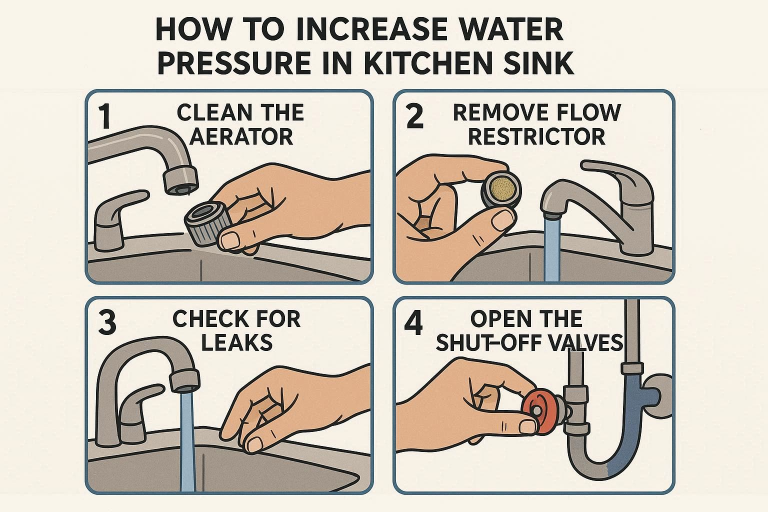Low water pressure in the kitchen sink can be frustrating. Whether you’re trying to fill up a pot for pasta or wash dishes, a weak water flow can slow you down and make everyday tasks feel like a chore. Beyond the inconvenience, persistent low water pressure can also indicate underlying issues in your plumbing system.
Fixing low water pressure isn’t just about convenience; it’s about functionality and long-term maintenance of your kitchen’s plumbing. Fortunately, most of the solutions are simple and cost-effective. In this blog, we’ll walk you through a step-by-step guide on how to fix low water pressure in your kitchen sink, explore Healthy Cooking Gadgets common causes, and provide tips to prevent future issues.
Why is Water Pressure Low in the Kitchen Sink?
Low water pressure can be caused by a variety of issues, from simple clogs to more complex plumbing problems. Understanding these causes is the first step in diagnosing and fixing the issue.
Common Causes of Low Water Pressure
- Blocked or Clogged Aerator
- The aerator is a small mesh filter at the tip of your faucet that controls water flow and prevents splashing. Over time, it can get clogged with mineral deposits, dirt, and debris, causing low water pressure.
- Issues with the Water Supply Line
- If the supply line feeding your kitchen sink is clogged or partially blocked, this can restrict water flow. The problem could be internal, such as sediment buildup, or external, like kinks or bends in the pipe.
- Problems with the Faucet Valve or Cartridge
- A malfunctioning valve or cartridge inside the faucet can prevent water from flowing smoothly. A clogged or damaged valve might restrict the flow, causing lower pressure.
- Corrosion in Pipes
- Older homes with galvanized steel pipes can experience corrosion over time. Rust and buildup inside the pipes will reduce water flow, leading to low pressure.
- Water Pressure Regulator Malfunction
- Some homes have a pressure regulator to control the overall water pressure. If this regulator fails or is improperly set, it can lead to low pressure in specific faucets or the entire home.
How to Diagnose Low Water Pressure in the Kitchen Sink
Before you start fixing the problem, it’s essential to determine whether it’s isolated to the kitchen sink or affects the entire house.
- Check if the Issue is Just the Kitchen Sink or the Entire Home
- If other faucets in your home (like the bathroom sink or shower) also have low pressure, the issue might be with your main water supply or the pressure regulator.
- Use a Pressure Gauge to Test Water Pressure
- To measure your water pressure accurately, use a pressure gauge. Please attach it to an outdoor faucet or another fixture with an accessible hose connection. The standard water pressure for most homes should be between 40 and 60 psi (pounds per square inch).
- Compare Cold and Hot Water Pressure
- If only your hot water is low, the issue could lie with your water heater. A clogged hot water line or sediment buildup in the tank can affect pressure.
Step-by-Step Guide to Increasing Water Pressure in Your Kitchen Sink
Now that you know what might be causing the issue, let’s dive into practical, actionable steps to restore proper water pressure.
1. Clean or Replace the Faucet Aerator
The aerator is often the culprit when it comes to low water pressure. It’s designed to mix air with water, creating a steady, controlled flow. If the aerator is clogged with debris, it can restrict water flow.
- How to Clean or Replace It
- Turn off the water supply to your sink.
- Use pliers to remove the aerator from the faucet (if it’s screwed on).
- Soak the aerator in vinegar for about 30 minutes to dissolve mineral deposits.
- Use a toothbrush to scrub away any remaining debris.
- If cleaning doesn’t work, replace the aerator with a new one, available at most home improvement stores.
2. Check the Water Supply Valve
The water supply valve under your sink controls the flow of water into your faucet. If the valve is partially closed, it can significantly reduce water pressure.
- Steps to Check the Valve
- Locate the water supply valve under the sink (there are usually two: one for hot water and one for cold).
- Turn the valve fully counterclockwise to ensure it’s fully open.
- If the valve is stuck or damaged, consider replacing it.
3. Inspect and Clean the Faucet Cartridge
The faucet cartridge is responsible for regulating water flow and temperature. Over time, mineral deposits or sediment can clog the cartridge, leading to reduced water pressure.
- How to Clean or Replace the Cartridge
- Shut off the water supply.
- Remove the handle of the faucet and unscrew the retaining nut.
- Remove the cartridge and inspect it for buildup.
- Clean the cartridge by soaking it in vinegar or use a small brush to scrub away debris.
- If the cartridge is too clogged or damaged, replace it with a new one, which can be found at most hardware stores.
4. Clear Blockages in the Pipes
Clogged pipes are a common cause of reduced water pressure. Over time, sediment, grease, or debris can accumulate inside your pipes, restricting water flow.
- How to Clear Pipe Blockages
- Use a plunger to clear minor clogs in the drain.
- For more severe blockages, consider using a pipe cleaning solution or a plumber’s snake to dislodge debris.
- If you’re unsure or the blockage is deep inside the plumbing, it’s best to call a professional plumber.
5. Check for Leaks in the Plumbing System
Leaks can drain water pressure by diverting water away from its intended destination. Leaking pipes, fittings, or connections could reduce your kitchen sink’s pressure.
- How to Identify Leaks
- Inspect visible plumbing under your sink for signs of leaks, such as wet spots or rust.
- If you suspect leaks inside the walls or other hidden areas, you may need a professional plumber to perform a more in-depth inspection.
6. Adjust the Pressure Regulator (If Applicable)
If your home has a water pressure regulator installed, it could be miscalibrated, leading to low pressure.
- How to Adjust the Pressure Regulator
- Locate the pressure regulator, which is usually near the water meter or where the main water line enters your home.
- Use a wrench to adjust the screw on the regulator (consult your regulator’s manual for exact instructions).
- If adjusting the regulator doesn’t help, it might need to be replaced.
7. Replace Old or Corroded Pipes
Old, corroded pipes, particularly those made of galvanized steel, can severely reduce water pressure. Corrosion buildup inside the pipes creates blockages, restricting water flow.
- When to Replace Pipes
- If you have rust-colored water or consistently low water pressure, it could be time to replace your old pipes.
- Replacing pipes is a significant project, so consider consulting a professional plumber to assess the situation.
Additional Tips for Maintaining Optimal Water Pressure in the Kitchen Sink
Once you’ve increased your water pressure, it’s essential to keep it in top condition.
Install a Water Pressure Booster
If your home suffers from consistently low water pressure, installing a water pressure booster can provide a long-term solution.
- How It Works
- A water pressure booster is a pump that increases the water pressure coming into your home, particularly useful if you live in an area with low municipal water pressure.
Use a Water Softener
Hard water can cause mineral buildup inside your pipes and faucet components, reducing water flow and pressure.
- How a Water Softener Helps
- A water softener removes minerals like calcium and magnesium, preventing scale buildup and maintaining good water pressure over time.
Regular Plumbing Maintenance
To avoid future pressure issues, schedule regular plumbing inspections. A proactive approach will help catch any problems early.
- Maintenance Tips
- Inspect faucet aerators, clean pipes, and check for leaks at least once a year.
When to Call a Professional Plumber
If you’ve tried all the DIY methods and still experience low water pressure, it may be time to call a professional plumber.
Signs You Need Professional Help
- Persistent low water pressure despite troubleshooting.
- Major leaks or corroded pipes.
- Issues affecting multiple fixtures in the house.
How to Choose the Right Plumber
- Look for a licensed, insured plumber with good reviews.
- Get multiple quotes and ask about their experience with water pressure issues.
- When the plumber arrives, expect a full inspection and a detailed breakdown of the problem.
FAQ (Frequently Asked Questions)
What should I do if cleaning the aerator doesn’t fix the water pressure?
If cleaning the aerator doesn’t work, check the water supply valve, inspect the faucet cartridge, or clear any pipe blockages.
Can a water pressure booster fix low pressure in just the kitchen sink?
Yes, a booster can help increase water pressure for a single faucet or an entire house. It’s especially effective if the pressure issue is widespread.
How often should I clean or replace my faucet aerator?
It’s a good idea to clean your aerator every 6-12 months, or sooner if you notice a reduction in flow.
How can I prevent future low water pressure in the kitchen sink?
Regularly check for leaks, clean your aerators, and replace any worn-out faucet components. Consider installing a water softener to prevent mineral buildup.
Will replacing old pipes always fix low water pressure?
Replacing old pipes can resolve pressure issues caused by corrosion or blockages. However, it’s not always necessary if the problem lies elsewhere in the system.
Conclusion
Low water pressure in your kitchen sink doesn’t have to be a permanent problem. With these step-by-step solutions, you can restore your faucet’s water pressure and ensure it stays that way. From cleaning the aerator to replacing old pipes, these tips cover all the essential fixes. And if the issue persists, a professional plumber can help resolve more complex plumbing problems.
So, roll up your sleeves and get started with these DIY fixes—your kitchen sink will be flowing freely in no time!

